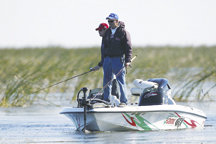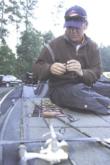Hors d’oeuvres
Finesse jigheads effective for all bass species

Ball-head, dart-head, dink-head, shaky-head – the finesse jighead has many names, including “hors d’oeuvres,” or at least that’s the way Castrol pro David Dudley of Lynchburg, Va., sees it.
When teamed with a finesse worm, these tiny lead-head jigs are effective on all bass species. Yet these mere appetizers are often scorned by shallow-water bank beaters who refuse to put down their bigger steak-and-potato offerings.
“They can say what they want about jighead finesse worms,” Dudley said. “But a bass is like a human – no matter how big a boy you are, a little hors d’oeuvre always tastes good.”
Diminutive finesse jigheads are really nothing new in bass fishing. For years, Western anglers have threaded tiny worms onto small “dart-heads” to ply clearwater impoundments for wary bass.
Several decades ago, the late lure designer Charlie Brewer of Tennessee poured a hook into a small piece of flat lead, put a skinny worm on it and called it a Slider rig because of the way the small bait “slid” through the water column.
The lure caught on as a cure for finicky, clearwater bass in the East, especially spotted and smallmouth bass.
In the mid-1990s, a tournament angler named Fred “Taco” Bland carved out a niche for finesse jigheads in bass tournaments on Southeastern impoundments. Bland beefed up his design of the jighead to include a longer, stronger hook so a bigger worm could be coupled with the tiny head.
 Over the last few years, finesse jigheads have caught fire on the Wal-Mart FLW Tour. They are always a bassing staple at the perennial Wal-Mart Open on Beaver Lake, and recently, Luke Clausen of Spokane, Wash., won $500,000 at the FLW Tour Championship on Logan Martin Lake with a finesse jighead.
Over the last few years, finesse jigheads have caught fire on the Wal-Mart FLW Tour. They are always a bassing staple at the perennial Wal-Mart Open on Beaver Lake, and recently, Luke Clausen of Spokane, Wash., won $500,000 at the FLW Tour Championship on Logan Martin Lake with a finesse jighead.
Today a slew of tackle companies make finesse jigheads in all shapes and sizes, but the equipment used to fish them is fairly standard.
The basic components are a medium-to-medium-heavy spinning rod in the 6 1/2-foot range, 6- to 10-pound-test line, a 1/16- to 1/4-ounce jighead and a 4- to 6-inch finesse worm. Although some anglers will thread the worm all the way on the hook and fish it open, it has become more acceptable to Texas-rig the worm on the jighead in order to make it weedless.
Buford, Ga., pro Tom Mann Jr. has been fishing finesse jigheads for 20 years on his home waters of Lake Lanier in Georgia.
“I don’t go anywhere without that little worm ready to go in the rod box,” Mann said. “It’s a universal fish-catcher. It will catch spots, largemouths and smallmouths in any kind of water from here to California.”
Over the years Mann has tweaked his finesse-jighead tackle to perfection. He uses 6- or 8-pound-test Transition Vanish fluorocarbon from Berkley, a 1/8-ounce Fred “Taco” Bland finesse jighead made by Bush Hog Lures and a 5-inch Yamamoto cut-tail worm, usually in green pumpkin or watermelon colors. He fishes the worm Texas-rigged to the jighead.
“I let the amount of cover dictate my line size,” he said. “If it’s open water with very little cover, like the smallmouth flats in the Northeast, I’ll go with 6-pound-test. But somewhere like Beaver Lake where standing timber is a factor, I’ll go to 8-pound-test.”
When it comes to technique, Mann admits that there is nothing complicated about fishing a finesse jighead.
“I just throw it out there and let it fall straight to the bottom with the bail open,” he said. “You want the bait to free-fall to the bottom without stopping. The bite almost always happens on the initial fall or as soon as it touches down on the bottom. Bass can’t stand that nose-down, tail-up presentation, especially spotted bass.”
Mann cautions that the hardest part of fishing these finesse rigs is feeling the bite.
“In 20 or 30 feet of water, you don’t usually feel that thump or bump like you do in shallow water,” he said. “It’s more of a steady pull or pressure, and your line will be moving in a funny direction. You have to be a line-watcher.
“Fluorocarbon, especially that Transition Vanish by Berkley, has made this kind of fishing so much easier,” he said. “The fluorocarbon sinks faster and is much more sensitive. Plus, what is unique about Transition is that it’s a high-vis yellow above the surface, and it becomes invisible below the surface, so watching your line with 6- and 8-pound-test just became a whole lot easier.”
Also, with 6-pound-test, this is not the time for jaw-breaking hooksets. Mann advises that the best set is to pull back and reel into the fish.
The simplicity and universal effectiveness of finesse jigheads has made them very popular with co-anglers on the FLW Tour.
Co-angler David Hudson of Jasper, Ala., has made 10 top-10s in FLW Tour competition, and he admits that his bread and butter has been a 4-inch Zoom Finesse Worm (green pumpkin) teamed with a 1/8-ounce finesse jighead tied to 8-pound line.
“I hardly go into a tournament day without it,” Hudson said. “I’ve even caught bass on Okeechobee with it. Most of the time it provides a total alternative presentation to the way my pro partner is fishing.”
Dudley has made it clear that he has no problem putting down the meat-and-potato baits to offer a largemouth an appetizer instead.
“A lot of people think a jighead worm is just for clear water and spotted bass,” Dudley said. “They’re wrong. It works good on largemouth lakes where there is a lot of fishing pressure, too.”
Last March, at a very tough FLW Tour event on Old Hickory Lake in Tennessee, Dudley caught a limit of 14-inch largemouths on a jighead worm after his crankbait bite went south.
“I caught some in practice on a crankbait along this 100-yard stretch of creek-channel bank,” Dudley said. “I went there in the tournament and made several passes with the crankbait without a bite. I knew the fish were still there, so I pulled out my jighead worm and caught a limit in about an hour and a half.”
Dudley also recommends having a jighead worm tied on for the last few minutes of fishing around the ramp just before tournament check-in.
“You know how everyone makes a few last casts to the same stuff outside the off-limits – the riprap, bridge pilings, docks and whatever else is right there?” he said. “They usually just chunk what they’ve been throwing all day – spinnerbaits, jigs, crankbaits. Well, that’s when the little bitty worm really shines; that’s when those bass will pass up the meat and potatoes for an hors d’oeuvre.”